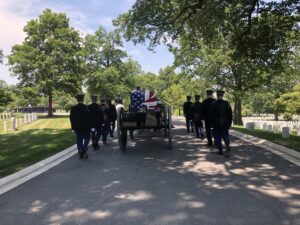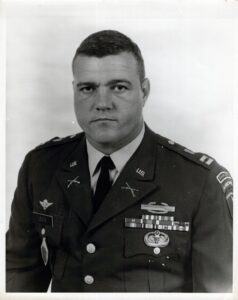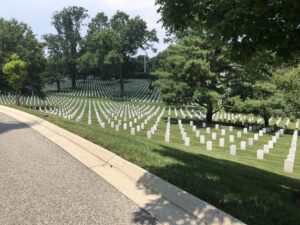Arlington National Cemetery, July 1, 2022
Fayettenam [now to be called Disequilibria: Meditations on Missingness] focuses intermittently on the 1982 disappearance of my stepfather, James Edward Lewis, a Vietnam veteran.
Earlier this month, nearly forty years on, we attended a memorial service for my stepfather. My brother Kevin worked hard for several years, finally reaching the right person in the right office to make it happen.
So, a stone was set in Arlington National Cemetery. On the first of July, we traveled there to attend the memorial ceremony.
Ritual makes me uncomfortable. The gap between public and private, regulated and chaotic, is, to me, disquieting. When my first father died, many years ago, I was angry at the wash-out of his personality put forth by the eulogist, a Baptist minister who never knew my father, Bob Lunday. While listening, I wanted the man to admit to my first father’s complexities – his mistakes, his faults, which had shaped our lives as much as the good in him.
 The service for my stepfather a few weeks ago was not closure, because the long-term missing can’t have closure in its conventional forms. People who look for the missing seek ways of shutting off, even cauterizing. Each searcher processes missingness differently. Some people concoct a bit of comfort through legal declarations, but resolution might come from nothing more than insistence within one’s own unsettled mind. We expel the bad emotions and move on.
The service for my stepfather a few weeks ago was not closure, because the long-term missing can’t have closure in its conventional forms. People who look for the missing seek ways of shutting off, even cauterizing. Each searcher processes missingness differently. Some people concoct a bit of comfort through legal declarations, but resolution might come from nothing more than insistence within one’s own unsettled mind. We expel the bad emotions and move on.
The opposite is also common: living one’s life through the mystery itself, with no end, such that the missingness becomes a mission. Others might see that mission as obsession.
Everything is an aspect of missingness; everything’s on a continuum between presence and absence, never stable, always coming or going. That seems to me a useful heuristic. It’s become my creative force.
My stepfather’s service was an impressive display of formality, collective spirit, patriotism, history – even of supernaturalism, at least as I experienced it, there in the vast, green, shaded fields of the dead, who at Arlington number nearly half a million. Two times during the procession and the graveside ritual, I was overcome with grief that had, I’d thought, concluded long ago. It wasn’t really inside me, but more the general air of such a place.
The Army planted the simple stone marker on a hillside, near the gravestones of other Vietnam veterans – just a few yards from General Creighton Abrams. Nearly all of those stones have remains beneath them, but Lewis’ stone is just a marker – a certificate of sorts; closure, or a death however, whenever it happened.

James Edward Lewis, c. 1970
The stone was a body. Once again, James Lewis was a material being. His intimidating bulk, his bulldog head, the mirthful grin alternating with wrathful glare – all that was physical about a man, which had only ever been a temporary presence.
What struck me most during the Arlington ceremony was the sense of ongoingness. All around, the trees, grass, buzzing of insects, chirping of birds; blue sky, whisps of random cloud, the heat, the thickness of air, the pooling of seconds into minutes, and the broad tableau itself, of which we were a part. It’s a nation of the dead at Arlington, taken altogether a thing very much alive.
The ceremony itself was grand theater. A brass band played, then marched ahead. Along a winding lane under the oaks and elms, two white horses pulled the caisson that bore the empty metal casket. A soldier mounted on a third white horse led the way, followed by a team of Old Guard pallbearers. The eulogist, an Airborne chaplain, and the funeral director, a retired paratrooper, followed to the side of the caisson. Kevin and I walked slowly behind along a three-quarter mile route to the hillside where the marker was already in place. The rest of the family followed slowly in a rented minivan.
 We passed the thousands upon thousands of gravestones on either side of the lane. At the grave site (let’s call it one) the chaplain spoke his eulogy. It seemed real enough to me this time, as if the chaplain knew well enough, unlike the Baptist minister all those years ago at my first father’s service, who the dead man was. The pallbearers ritually lifted and folded the American flag above the empty casket. That highly stylized performance – turning the Stars and Stripes into a triangular cartouche of itself: a substitute body, a chevron of identity subsumed by whatever one thinks the flag represents: the State that uses and devours us, one’s love of home, the sacrifice of warriors, or just the weight of feeling, suddenly made light and fit firmly to one’s hands.
We passed the thousands upon thousands of gravestones on either side of the lane. At the grave site (let’s call it one) the chaplain spoke his eulogy. It seemed real enough to me this time, as if the chaplain knew well enough, unlike the Baptist minister all those years ago at my first father’s service, who the dead man was. The pallbearers ritually lifted and folded the American flag above the empty casket. That highly stylized performance – turning the Stars and Stripes into a triangular cartouche of itself: a substitute body, a chevron of identity subsumed by whatever one thinks the flag represents: the State that uses and devours us, one’s love of home, the sacrifice of warriors, or just the weight of feeling, suddenly made light and fit firmly to one’s hands.
From partway up the hill, then, the 21-gun salute – seven riflemen firing three times; at the opposite end of our ritual space, the bugler playing Taps.
In the periphery, one of the Arlington Army Ladies quietly witnessed, chaperoned by an equally-silent soldier. That’s been a tradition since the waning days of World War II, so no soldier is ever laid to rest without someone to see it. I was struck by the woman’s presence, somehow: as if her not-knowing our particular, personal experience was to know its essence. She marked a boundary, and also put a face on the impossibility of boundaries. There was the empty casket, the grave marker above nothingness; there was the family, the assembled soldiers, the riflemen and the bugler; there was the Arlington Army Lady and her escort, then the rest of the world that would stay as it was. Somewhere past sight, past the trees and multitude of graves, each of us was anonymous in that world. But here, for a little while, everyone was present and accounted for.
4 Comments
Bill Barnes · July 29, 2022 at 9:59 PM
Thank you for this, Robert. It is beautifully written and moved me deeply.
Robert Lunday · July 29, 2022 at 10:44 PM
Thank you so much, Bill!
Lisa Destro Erwin · September 15, 2022 at 6:59 AM
DearRobert, this is so beautifully written and captures the experiences of grief and acceptance so well. Thank You,
Lisa
Robert Lunday · September 15, 2022 at 8:25 AM
Thank you, Lisa!